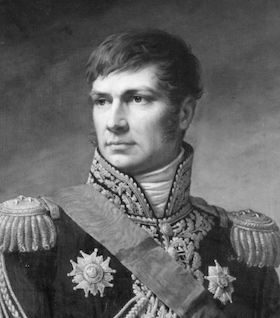General Etienne Radet

Born: December 19, 1762
Place of Birth: Stenay, Meuse, France
Died: September 28, 1825
Place of Death: Varennes, France
Enlisting in the infantry regiment of Sarre in 1780, Etienne Radet was sent to Saint-Domingue for part of his early career. He was dismissed in 1786 and he then entered the police forces as a cavalier. After the onset of the Revolution, in August of 1789 Radet resigned his post to become a sous-lieutenant in the National Guard. Three months later he was promoted to lieutenant, and then a year later he was promoted to capitaine. Radet next organized and formed the National Guard of Varennes, becoming its major in 1791, and then in March of 1792 he was promoted to chef de bataillon. That June he joined the 2nd Battalion of Volunteers of Meuse and he went on to serve at the defense of Verdun and then in the Army of the Ardennes. In September Radet became an aide-de-camp to General Dillon and then in 1793 he was employed in the Army of the Moselle and he served at Arlon in June. At the end of 1793 he took part in the recovery of the lines of Wissembourg as an aide-de-camp to General Dubois.
However, before long Radet was arrested for having allegedly corresponded with émigrés and supporting the attempted escape of the king in 1791. A revolutionary tribunal acquitted him of the charges and he rejoined Dubois as an aide-de-camp in February. In May of 1794 Radet was promoted to chef de brigade and he served as chief of staff of the cavalry division commanded by General Dubois. That June he served at the Battle of Fleurus and then in July he served at the action of Mons. When the armies were reorganized he joined the Army of the Sambre and Meuse. Radet remained with the Army of the Sambre and Meuse and in July of 1796 he was attached to Bonnaud's division. Two months later he took part in a cavalry charge where he was run over by a horse and mutilated and unable to continue fighting. In April of 1797 Radet served as chief of staff of d'Hautpoul's cavalry division at Dierdorf. In 1798 Radet found his calling with the gendarmerie when he was ordered to reorganize the 24th Division of Gendarmerie at Avignon and bring peace back to the south. Two years later he was promoted to général de brigade and ordered to organize the gendarmerie throughout France.
In June of 1804 Radet was recognized as a Commander of the Legion of Honor. He went on to inspect the gendarmerie in Corsica, Piedmont, and Genoa. After the French had taken Naples in 1806, Radet went there to organize the gendarmerie. In 1808 he served in Tuscany and in 1809 he was sent to Rome. On the night of July 5th, 1809, Radet and his gendarmes climbed the walls of Quirinal Palace to summon the Pope to give up his temporal power. The pope refused and Radet arrested him and conducted him to Florence before turning him over to other gendarmes. Afterwards Radet returned to Rome and in 1810 he was named a Baron of the Empire. In 1811 Radet was sent to Hamburg to organize the gendarmerie there.
In March of 1813 Radet was named grand provost of the Grande Armée in Germany and then that November he was promoted to général de division. After Napoleon's abdication in April of 1814, Radet returned to his home and he was put on non-activity. When Napoleon returned from exile in 1815 to resume power for the Hundred Days, he first ordered Radet to Lyon to take command of the gendarmerie of the 7th, 8th, and 19th military divisions. Radet was then named inspector general of the gendarmerie. Next he was sent to accompany the Duke of Angoulême and escort him from Sète where he had been forced to surrender. That June Radet was named grand provost of the army in Belgium and he served at the Battle of Waterloo where he was wounded in the left knee and the hip. After Napoleon's second abdication, Radet was arrested in January of 1816 and taken before the 1st council of war of the 6th military division at Besançon. At the trial he was found guilty of convincing subjects to ignore their military duties, to abandon their faithfulness to their legitimate sovereign, and to join the rebellious party. Radet was sentenced to nine years of prison and he was imprisoned at the citadel of Besançon. In 1818 he was pardoned for the remainder of his sentence.
Bibliography
Related Pages:
Updated August 2017
© Nathan D. Jensen